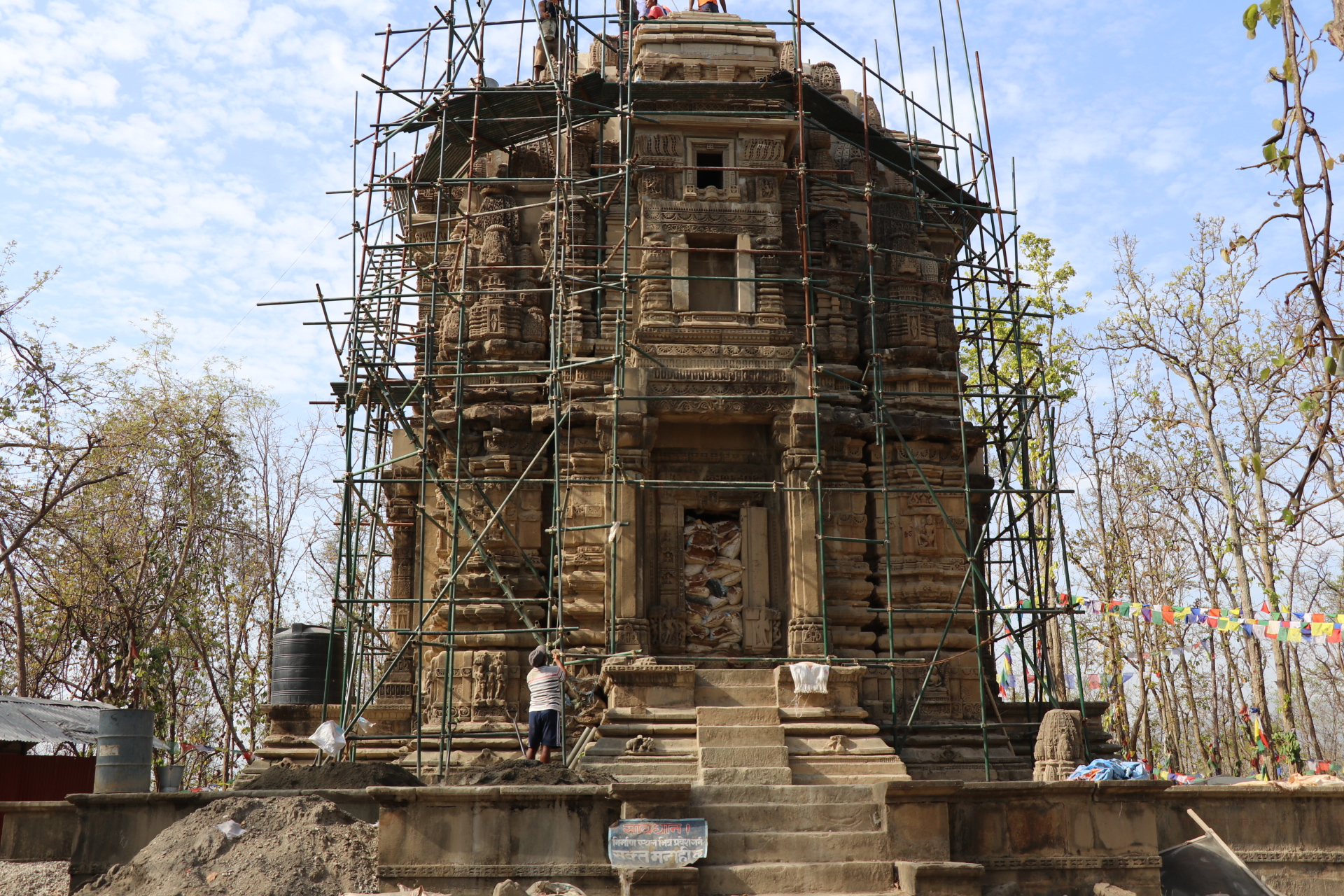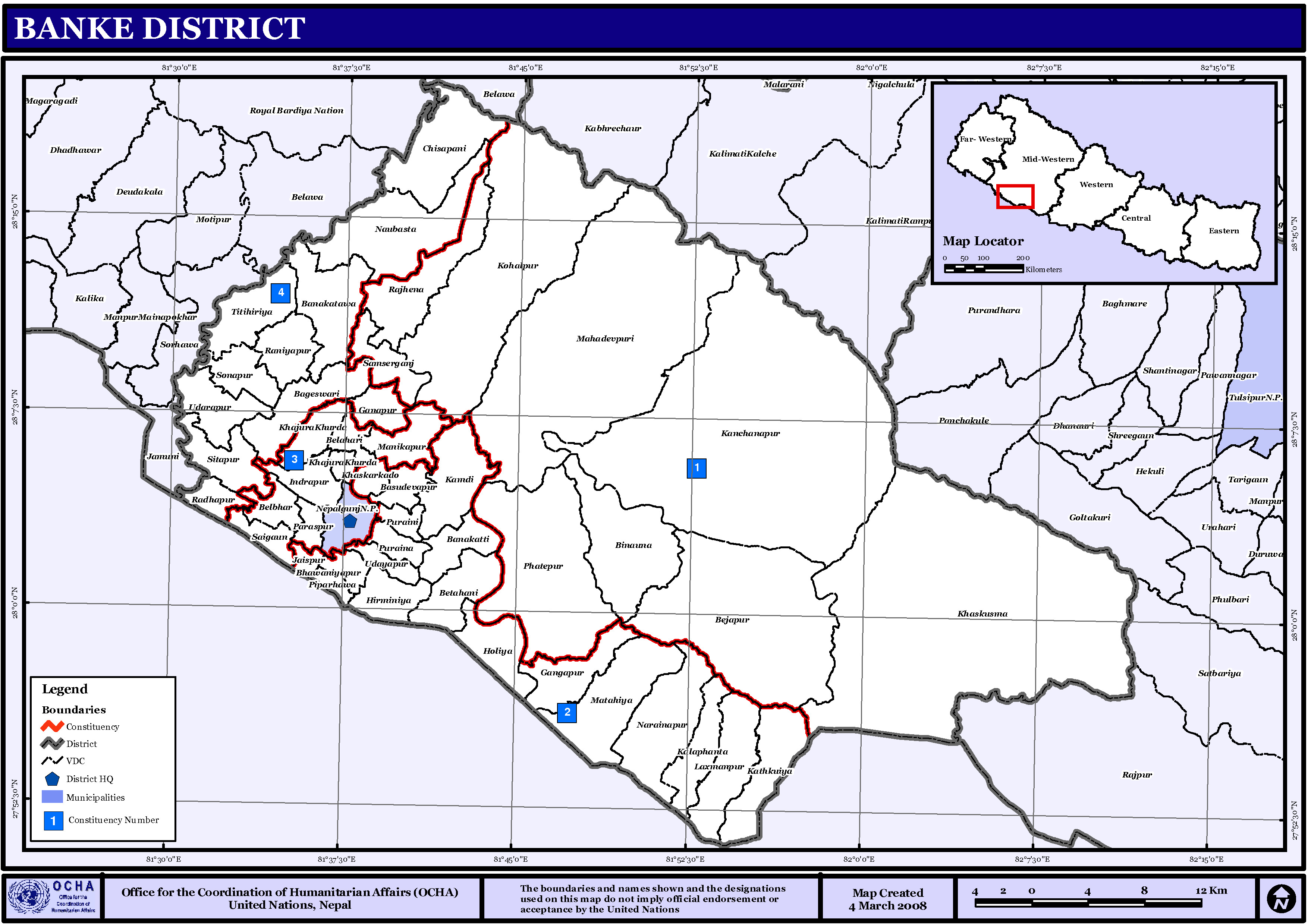|
Surkhet District
Surkhet District (, ) is a district in Karnali Province of mid-western Nepal. Surkhet is one of the ten districts of Karnali located about west of the national capital Kathmandu. The district's area is . It had 288,527 population in 2001 and 350,804 in 2011 which male comprised 169,461 and female 181,381. Its district headquarters, Birendranagar, is the capital of Karnali Province. It is serving as a business hub and document center for Karnali province. According to population, development, road links, landforms, climate, many peoples are migrating here. After becoming province capital developmental activities are boosted and are in peak level. All the governmental works are carried here. Birendranagar is beautiful valley surrounded by hills having moderate climate. Geography and Climate Surkhet Valley is one of the Inner Terai Valleys of Nepal. It borders Achham district of Sudurpashchim, Dailekh and Jajarkot districts to the north, Salyan district to the east, Banke and ... [...More Info...] [...Related Items...] OR: [Wikipedia] [Google] [Baidu] |
Districts Of Nepal
Districts in Nepal are second level of administrative divisions after provinces. Districts are subdivided into municipalities and rural municipalities. There are seven provinces and 77 districts in Nepal. After the 2015 reform of administrative divisions, Nawalparasi District and Rukum District were respectively divided into Parasi District and Nawalpur District, and Eastern Rukum District and Western Rukum District. District officials District official include: * Chief District Officer, an official under Ministry of Home Affairs is appointed by the government as the highest administrative officer in a district. The C.D.O is responsible for proper inspection of all the departments in a district such as health, education, security and all other government offices. * District Coordination Committee acts as an executive to the District Assembly. The DCC coordinates with the Provincial Assembly to establish coordination between the Provincial Assembly and rural muni ... [...More Info...] [...Related Items...] OR: [Wikipedia] [Google] [Baidu] |
Temperate Climate
In geography, the temperate climates of Earth occur in the middle latitudes (approximately 23.5° to 66.5° N/S of the Equator), which span between the tropics and the polar regions of Earth. These zones generally have wider temperature ranges throughout the year and more distinct seasonal changes compared to tropical climates, where such variations are often small; they usually differ only in the amount of precipitation. In temperate climates, not only do latitudinal positions influence temperature changes, but various sea currents, prevailing wind direction, continentality (how large a landmass is) and altitude also shape temperate climates. The Köppen climate classification defines a climate as "temperate" C, when the mean temperature is above but below in the coldest month to account for the persistence of frost. However, some adaptations of Köppen set the minimum at . Continental climates are classified as D and considered to be varieties of temperate climates, ... [...More Info...] [...Related Items...] OR: [Wikipedia] [Google] [Baidu] |
Subtropics
The subtropical zones or subtropics are geographical and climate zones immediately to the north and south of the tropics. Geographically part of the temperate zones of both hemispheres, they cover the middle latitudes from to approximately 35° to 40° north and south. The horse latitudes lie within this range. Subtropical climates are often characterized by hot summers and mild winters with infrequent frost. Most subtropical climates fall into two basic types: humid subtropical (Köppen climate classification: Cfa/Cwa), where rainfall is often concentrated in the warmest months, for example Southeast China and the Southeastern United States, and dry summer or Mediterranean climate (Köppen climate classification: Csa/Csb), where seasonal rainfall is concentrated in the cooler months, such as the Mediterranean Basin or Southern California. Subtropical climates can also occur at high elevations within the tropics, such as in the southern end of the Mexican Plateau an ... [...More Info...] [...Related Items...] OR: [Wikipedia] [Google] [Baidu] |
Tropical Climate
Tropical climate is the first of the five major climate groups in the Köppen climate classification identified with the letter A. Tropical climates are defined by a monthly average temperature of or higher in the coolest month, featuring hot temperatures and high humidity all year-round. Annual precipitation is often abundant in tropical climates, and shows a seasonal rhythm but may have seasonal dryness to varying degrees. There are normally only two seasons in tropical climates, a wet (rainy/monsoon) season and a dry season. The annual temperature range in tropical climates is normally very small. Sunlight is intense in these climates. There are three basic types of tropical climates within the tropical climate group: tropical rainforest climate (Af), tropical monsoon climate (Am) and Tropical savanna climate, tropical savanna or tropical wet and dry climate (Aw for dry winters, and As for dry summers), which are classified and distinguished by the precipitation levels of the ... [...More Info...] [...Related Items...] OR: [Wikipedia] [Google] [Baidu] |
Geography Of Nepal
Nepal measures about along its Himalayan axis by across. It has an area of . Nepal is landlocked by China's Tibet Autonomous Region to the north and India on other three sides. West Bengal's narrow ''Siliguri Corridor'' separate Nepal and Bangladesh. To the east are Bhutan and India. Nepal has a very high degree of geographic diversity and can be divided into three main regions: Terai, Hilly, and Himal. The Terai region, covering 17% of Nepal's area, is a lowland region with some hill ranges and is culturally more similar to parts of India. The Hilly region, encompassing 68% of the country's area, consists of mountainous terrain without snow and is inhabited by various indigenous ethnic groups. The Himal region, covering 15% of Nepal's area, contains snow and is home to several high mountain ranges, including Mount Everest, the world's highest peak. Nepal, with elevations ranging from less than 100 meters to over 8,000 meters, has eight climate zones from tropical to perpe ... [...More Info...] [...Related Items...] OR: [Wikipedia] [Google] [Baidu] |
Doti District
Doti District ( ), part of Sudurpashchim Province, is one of the 77 List of districts of Nepal, districts of Nepal. This district, with Dipayal Silgadhi, Silgadhi as its headquarters, covers an area of with a population of 207,066 in 2001 and increasing marginally to 211,746 in 2011. History Doti was a Middle Ages, medieval Monarchy, kingdom of Kumaon Kingdom, Kumaon. It was founded by Niranjan Malla Dev, the last son of the Katyuri dynasty and younger brother of Abhay Pal of Askot. Previously, the area between Ramganga in the west and the Ghaghara, Karnali River in the east was under the control of the Raikas (rulers of the Doti kingdom, alternately Kumaon Kingdom, Kumaun or ''Rainka Maharaj''). Ancient Doti was a part of Kumaon Kingdom, Now remaining Kumaon division, Kumaon region is part of Uttrakhand a state in modern-day india, Nepal's neighboring country. Kingdom of Kumaon lost Doti during the expansion of Nepal Kingdom in 1790. It was formed after the Katyuri Kingdom's ... [...More Info...] [...Related Items...] OR: [Wikipedia] [Google] [Baidu] |
Kailali District
Kailali District (), a part of Sudurpashchim Province in Terai plain, is one of the 77 districts of Nepal. The district, with Dhangadhi as its district headquarters, covers an area of and has a population of 911,155 (2021 census) and (775,709 in 2011 census), (616,697 in 2001 census). Before the reunification of Nepal by Gorkha King Prithivi Narayan Shah, this district was part of the Doti Kingdom. Nepal lost it to the East India Company after the Anglo-Nepalese war (1814-1816) between the then Kingdom of Nepal and the East India Company followed by territorial concessions under the Sugauli Treaty. Later on after the treaty of 1860, Nepal recovered this land along with Kanchanpur, Banke and Bardiya. Geography and climate Demographics At the time of the 2011 Nepal census, Kailali District had a population of 775,709. As their first language, 41.5% spoke Tharu, 27.3% Nepali, 18.7% Doteli, 6.3% Achhami, 1.4% Magar, 0.9% Maithili, 0.8% Hindi, 0.5% Bajureli, 0.4 ... [...More Info...] [...Related Items...] OR: [Wikipedia] [Google] [Baidu] |
Lumbini Province
Lumbini Province () is a Provinces of Nepal, province in western Nepal. The country's Provinces of Nepal, third largest province in terms of area as well as List of Nepalese provinces by population, population, Lumbini is home to the World Heritage Site of Lumbini, where according to Buddhist tradition Gautama Buddha, the founder of Buddhism, was born. Lumbini borders Gandaki Province and Karnali Province to the north, Sudurpashchim Province to the west, and Uttar Pradesh and Bihar of India to the south. Lumbini's capital, Deukhuri, is near the geographic center of the province. The major cities in the province are Butwal and Siddharthanagar in Rupandehi District, Rupandehi district, Nepalgunj in Banke District, Banke district, Tansen, Nepal, Tansen in Palpa District, Palpa district, and Ghorahi and Tulsipur, Dang, Tulsipur in Dang District, Nepal, Dang district. Capital The Provincial Assembly adopted Lumbini Province as the permanent name by replacing its initial name ''Provi ... [...More Info...] [...Related Items...] OR: [Wikipedia] [Google] [Baidu] |
Bardiya District
Bardiya District (), one of the seventy-seven Districts of Nepal, is part of Lumbini Province of Nepal. The district, with Gulariya as its headquarters, covers an area of and according to the 2001 census the population was 382,649 in 2011 it has 426,576. Geography and climate Bardiya lies in Lumbini Province in midwestern Nepal. It covers 2025 square kilometers and lies west of Banke District, south of Surkhet District of Karnali Province, east of Kailali District of Sudurpashchim Province. To the south lies Uttar Pradesh, India. Most of Bardiya is in the fertile '' Terai'' plains, covered with agricultural land and forest. The northernmost part of the district extends into the ''Churiya'' or '' Siwalik Hills''. Bardiya National Park covers occupies most of the northern half of the district. This park is the largest undisturbed wilderness in Nepal's Terai. It provides forest, grassland and riverine habitat for endangered mammal, bird and reptile species. More than ... [...More Info...] [...Related Items...] OR: [Wikipedia] [Google] [Baidu] |
Banke District
Banke District (; , a part of Lumbini Province, is one of the 77 districts of Nepal. The district, located in midwestern Nepal with Nepalganj as its district headquarters, covers an area of and had a population of 385,840 in 2001 and 491,313 in 2011. There are three main cities in the Banke District: Nepalganj, Kohalpur and Khajura Bajaar. Geography and Climate Banke is bordered on the west by '' Bardiya district''. '' Rapti zone's'' ''Salyan'' and '' Dang Deukhuri Districts'' border to the north and east. To the south lies ''Uttar Pradesh'', India, a country in Asia; specifically ''Shravasti'' and '' Bahraich districts'' of ''Awadh''. East of Nepalganj the international border follows the southern edge of the '' Dudhwa Range'' of the ''Siwaliks''. Most of the district is drained by the ''Rapti'', except the district's western edge is drained by the ''Babai''. Rapti and Babai cross into Uttar Pradesh, a state in India, Nepal's neighboring country and eventually join the ... [...More Info...] [...Related Items...] OR: [Wikipedia] [Google] [Baidu] |
Salyan District, Nepal
Salyan District () IPA: ʌljan in Karnali Province, is one of the seventy-seven districts of Nepal. Salyan covers an area of with a population of 213,500 in 2001 and 241,716 in 2011. The district's administrative center is named Salyan or ''Salyan Khalanga'', today it is part of Shaarada Municipality. The district is known for its Hindu temples including Shiva temples in Chhayachhetra and Laxmipur, and the Devi temple at Khairabang in Shaarada municipality, one of nine in Nepal. History Salyan was one of the ''Baise Rajya'', a confederation of 22 petty kingdoms in the Karnali (Ghagra) region. It was ruled by Samala Shahis before unification. About 1760 CE all these kingdoms were annexed by the Shah Dynasty during the unification of Nepal. Etymology ''Salyan'' derives from the Nepali word ''sallo'' which means pine tree or conifer. Geography and climate Although Salyan is considered a hilly district, its southwest salient is actually outside the Pahari-inhabited h ... [...More Info...] [...Related Items...] OR: [Wikipedia] [Google] [Baidu] |






